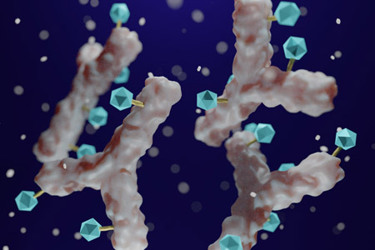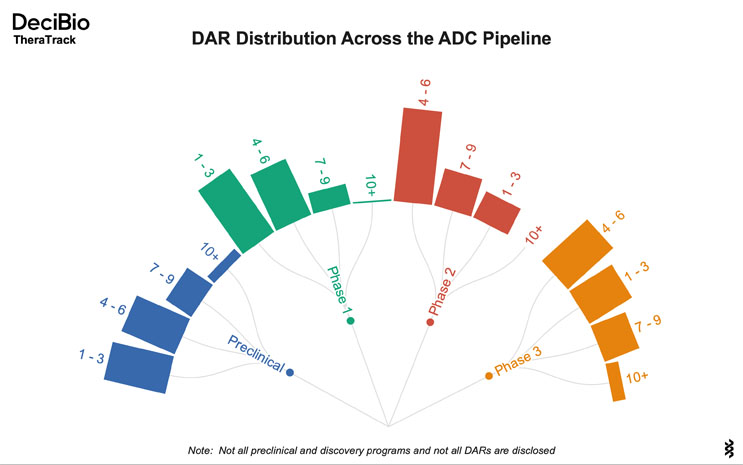ADC Advancements Allowing For Higher DAR

By Tyler Menichiello, Chief Editor, Bioprocess Online

I recently published a story about my interview with DeciBio’s Dr. Joe Daccache, where we discussed how advancements in linker technology are driving innovation in the field of antibody-drug conjugates (ADCs). Shortly after, I met with Daccache again to discuss how these advancements in linker technology, as well as a rise in novel conjugation platforms, have enabled higher drug-to-antibody ratios (DAR). These developments are ushering in a new era of ADCs, allowing for more targeted chemotherapies with improved efficacy, as well as a rise in “funky,” unconventional payloads for uses beyond just targeted chemotherapies.
The Evolution Of DAR

To improve efficacy, developers began wondering if there was a way to increase the drug concentration by conjugating more chemotherapy molecules to a single antibody. “That’s where the concept of DAR came into play,” Daccache explains. However, at the time, flaws in linker technology and antibody targeting stifled this approach. Linkers were unstable (leading to premature cleavage, or release of payload) and antibodies weren’t optimally targeted, which resulted in very high off-target toxicity. Thus, increasing the DAR resulted in more off-target tissue damage and “hurt more than it helped.”
According to Daccache, this put the idea in a lot of people’s minds that high DAR equals high toxicity. However, improvements to linker technology (namely increased stability and site-specific cleavage) have allowed for the conjugation of more payload to ADCs without the off-target toxicities seen in previous generations. These upgraded linkers, coupled with more tumor- and tissue-specific antibodies, allow for high-DAR ADCs with improved efficacy and less off-target effects. He cites Enhertu as an example, a HER2-targetting ADC with a DAR of 8. Since HER2 is over-expressed in a handful of cancers (primarily in breast cancer) and minimally expressed in healthy tissues, it makes for a strong target, ensuring that the cytotoxic payload kills the desired tissues.
“It’s all about balance,” Daccache explains. “First, the drug target needs to make sense. When you have a drug target that’s almost non-existent in healthy tissues, combined with a high DAR and a stable linker, you’re going to see higher efficacy.” ADCs like Enhertu make a strong case for the efficacy of a high DAR — when the linker technology and the antibody target are optimal, a high DAR can be beneficial. Biotechs like Dantari are taking this hypothesis to the next level — it has a preclinical ADC in its pipeline with a DAR of 60.

Conjugation Methods Can Make Or Break Your ADC
In our last conversation, Daccache explained the growing trend of biotech companies like Synaffix that develop linker technology platforms and license them out for use in other companies’ ADCs. A big part of these licensing deals not only has to do with the linker technology itself, but also, and just as importantly, the conjugation methods. Conjugation refers to the process of connecting the antibody to the payload, and it usually happens in two parts: connecting the linker to the antibody and the payload to the linker, or vice versa, depending on the starting materials. According to Daccache, there’s a lot of IP surrounding conjugation. “You need to find that unique payload site to conjugate to the linker, as well as a unique antibody site that you can conjugate the linker to,” he explains. “That double conjugation is what gives you a proprietary platform.”
As important as it is to have an ideal antibody and stable linker, without a sound conjugation process, you can’t develop an effective therapy. If this process isn’t optimized, you can end up with naked antibodies (no payload), or a heterogeneous mix of ADCs with varying DARs. In either case, from a regulatory perspective, no ADC can be approved without a consistent, reproducible conjugation process that ensures a nearly homogenous mixture of conjugated ADCs. This is what makes conjugation platforms so valuable, and why there is so much IP surrounding them. As a developer, it’s important to decide early on if you’re willing to develop your own process, or if it makes more sense to license something that’s already been proven in the market.
Note To Manufacturers
Successful manufacturing of ADCs depends on the conjugation process, and not all payloads are conjugated equally. “Manufacturing a radioisotope ADC is not the same as manufacturing one with a chemotherapy molecule,” Daccache explains. He says the field is steadily moving towards unconventional, “funky” payloads, ranging from immunostimulatory payloads to radioisotopes that can be used for imaging and radiotherapy. “This innovation is what’s currently leading to some of the manufacturing hurdles; being able to not only provide unique payloads, but also being able to work around that conjugation at the commercial or late-stage level.”
From novel conjugation platforms to unique linkers and payloads, the ADC landscape is evolving rapidly, and it’s a lot to keep up with. Daccache says manufacturers should pick what services they can offer ADC developers and stick with it. “ADCs are moving like a train,” he says. “If you want to jump on the train, you can’t keep jumping between the different cars. You have to pick one and stay on it until you are stable and in a confident position. Then you can think about jumping onto the next one.”
